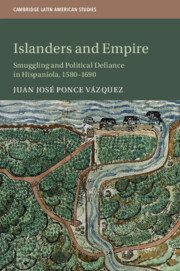Book contents
- Islanders and Empire
- Cambridge Latin American Studies
- Islanders and Empire
- Copyright page
- Dedication
- Contents
- Figures and Tables
- Acknowledgments
- Additional material
- Introduction
- 1 Colonial Origins: Hispaniola in the Sixteenth Century
- 2 Smuggling, Sin, and Survival, 1580–1600
- 3 Repressing Smugglers: The Depopulations of Hispaniola, 1604–1606
- 4 Tools of Colonial Power: Officeholders, Violence, and Exploitation of Enslaved Africans in Santo Domingo’s Cabildo
- 5 “Prime Mover of All Machinations”: Rodrigo Pimentel, Smuggling, and the Artifice of Power
- 6 Neighbors, Rivals, and Partners: Non-Spaniards and the Rise of Saint-Domingue
- Conclusion
- Glossary of Spanish Terms
- Bibliography
- Index
- Other Books in the Series (continued from page ii)
6 - Neighbors, Rivals, and Partners: Non-Spaniards and the Rise of Saint-Domingue
Published online by Cambridge University Press: 23 October 2020
- Islanders and Empire
- Cambridge Latin American Studies
- Islanders and Empire
- Copyright page
- Dedication
- Contents
- Figures and Tables
- Acknowledgments
- Additional material
- Introduction
- 1 Colonial Origins: Hispaniola in the Sixteenth Century
- 2 Smuggling, Sin, and Survival, 1580–1600
- 3 Repressing Smugglers: The Depopulations of Hispaniola, 1604–1606
- 4 Tools of Colonial Power: Officeholders, Violence, and Exploitation of Enslaved Africans in Santo Domingo’s Cabildo
- 5 “Prime Mover of All Machinations”: Rodrigo Pimentel, Smuggling, and the Artifice of Power
- 6 Neighbors, Rivals, and Partners: Non-Spaniards and the Rise of Saint-Domingue
- Conclusion
- Glossary of Spanish Terms
- Bibliography
- Index
- Other Books in the Series (continued from page ii)
Summary
During the final decades of the 1600s, French and Spanish residents in Hispaniola had developed a deeply ambivalent yet fluid relationship that ranged from the open violence to collaboration in their daily dealings. By the end of the century, however, Spanish residents on the island, especially in the north, came to rely on French merchants and settlers, who provided Hispaniola residents with a certain level of economic prosperity that legal (and illegal) Spanish traders operating in Santo Domingo could only provide at much higher prices and limited quantities. This rise of the intercolonial trade between both sides of the island happened as the efforts of the Spanish crown to eliminate French settlements from Hispaniola also increased. The participation of Spanish local residents in the war effort allowed them to manipulate the Spanish offensive and foil the imperial objective of consolidating Spanish control over all of Hispaniola, thus choosing the commercial benefits of accommodation to the neighboring French presence, despite the risks, instead of a safe reunification under Spanish control that would once again commercially isolate them.
- Type
- Chapter
- Information
- Islanders and EmpireSmuggling and Political Defiance in Hispaniola, 1580–1690, pp. 223 - 262Publisher: Cambridge University PressPrint publication year: 2020



